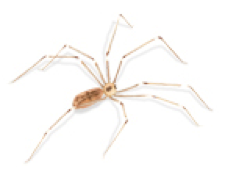Our affiliates






Our goal is to solve your pest problems with professionalism and use the best techniques to not leave residue and maintain a clean environment in your homes.
View coupons.

• 7-9mm long
• Characterized by having very long legs
• The female lays eggs , and can sometimes take its eggs in its palps ( short legs like structures attached to the front of the carapace between the teeth and the first pair of legs )
• They produce their canvas normally in sheltered areas , often in and around human habitation , including houses , garages and sheds
• Apart from the nuisance of their webs , they do no harm and are not toxic
• They are common in urban areas
• They feed on insects and other spiders

• Adult – body length excluding legs 1/4 « – 3/8 » . Yellow brown body with faint markings . Abdomen pale- brown and gray short hair .
• The egg sac produced by the female is spherical , covered with a layer of tissue and placed inside of the fabric structure .
• The male will mate several times with the woman before she died.
• Adults may live for several years.
• Find in buildings , sheds and walls.
• This spider produces a sheet of canvas.

• 1/4 to 3/4 inch long.
• Colour brown or dark yellow .
• Slim, long brown legs covered with fine hairs .
• Six eyes, arranged in pairs in a semicircle.
• Eggs are laid primarily from May to July .
• The female lays about 50 eggs in a white silky sac off diameter about 2/3 inch.
• Spiders come out about 1 month later.
• It takes about a year to reach the adult stage.
• Adults can live 1-2 years
• Locations – They prefer isolated places, dark, undisturbed inside or outside sites. Inside, they can be found in attics, basements, closets, conduits, in storage boxes, shoes or behind furniture. Outwardly they can be found in barns, storage sheds, garages, under logs, loose stones and wood piles.
• Food – They prefer dead insects. They can survive about 6 months without food or water.
• Visibility – The sac serves to feed day. They tend to look for food at night.
• They only bite when crushed, handled or disturb. Both sexes are venomous. The reaction of a man to the bite depends on the amount of venom injected and the sensitivity of an individual – some people are unaffected, others may feel a sting, others a burning sensation, followed by intense pain. Some may not be aware of the bite for 2 to 8 hours.